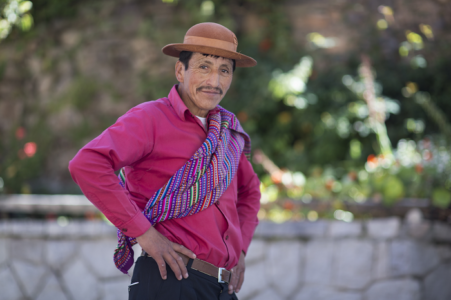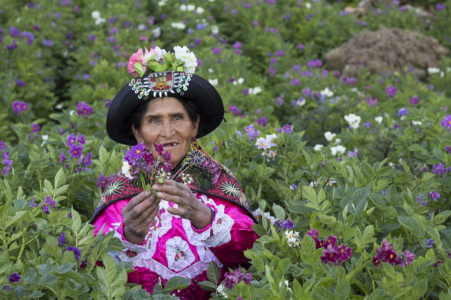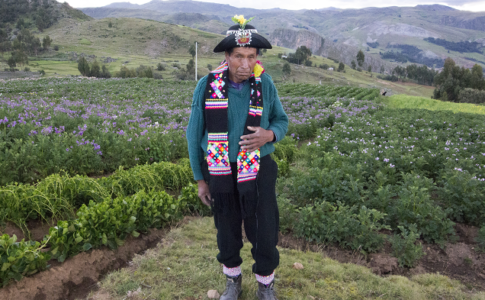The Andes mountain range is one of the world’s richest centers of agrobiodiversity. For generations, custodian farmers have maintained more than 4,000 potato landraces and a comparable diversity of indigenous crops such as quinoa and amaranth. As climate change exacerbates extreme fluctuations in weather, the Andes essentially becomes a living laboratory. Custodian farmers are crucial to understanding the impact of a changing environment on agrobiodiversity and the people who rely on it. Members of the Association of Guardians of Potato Landraces of Central Peru (AGUAPAN for its name in Spanish) share their thoughts on climate change.
 Marcelo Tiza
Marcelo Tiza
Quilcas, Huancayo, Peru
Year after year the impacts of climate change worsen as a result of torrential rains, late rains, or short rains. Potato Late Blight affects our potatoes as a result of this dampness. The presence of frost is no longer in December, there is frost in January, In February even at the end of March when the potato is in full bloom, all of that affects our native potatoes. Our concern as farmers is the biodiversity of potatoes, but not just the risk of losing our potatoes, as custodians we use fertilizers we get from our sheep, our cattle, and our llamas. We risk losing livestock, as is happening in other regions of our Peru. We are going to have prolonged drought. We’ll have dry grasses and our animals are going to lack the food they need and even the water. Natural springs are fed from ice, their levels and flow will lessen. As a result, we’ll lose our irrigation channels.
 Ruth Cueva
Ruth Cueva
Laraos, Lima, Peru
I live 3,500 meters (11,482 feet) above sea level. I have native potatoes that my grandparents left me, and I’ll leave them to those come after me. Our biodiversity does us good. We take care of it as if it were family, like another person beside us, that needs our attention. I don’t think I’ll get to farm even 100 native potato varieties; I might get to 80 more or less. I’ve lost about 40 varieties due to Climate Change, from pests, frost, and Late Blight. Seeing that these potatoes are lost makes me sad because if someone harvests a pretty potato, one that is clean, one feels happy. One can sell them or trade them for something else. This year there was a lot of frost and hail. It was a terrible loss for us potato farmers, but not just in potato, in corn as well, olluco, and oca. The frost hit all those crops, and we just can’t deal with this weather. We can’t fight so much because even though we have our customs of how to do it we can’t have it all close at hand.
 Damiana de la Cruz
Damiana de la Cruz
Yauli Community, Huancavelica, Peru
Observing the trees, I saw the effects of climate change. Now when we plant potatoes and when we eat them, we see the changes. When I look at potatoes, I observe that the hail has caused a lot of damage. When the snow falls, it cripples potato and turns it dusty like ashes. Late Blight comes when there is a lot of rain. Fungus and Late Blight stunt potato and makes it smell bad. They affect potato down to the bone. But if you start peeling away at the potato, you find that its heart is not affected by any diseases. Everything we plant to eat, we have to select. We clean them, we care for them, and we use only natural fertilizer. Our potatoes, like us, know no chemicals. We know about cultivating potato since the time of our ancestors. Diseases enter through the neck of the potato if the hole for planting is too wide. The seeds we plant can’t be squashed. There are thousands of worm eggs in accumulated grasses. You have to look for and remove the grasses. That’s what we do, so no worms get into our potatoes. The potatoes come out as fresh as lettuce, so beautiful, and they bring life to the land. We have 1,800 varieties of potatoes in different colors. Inside, their pulp is like blood. When you slice them, the knife’s blade drips. We could show others this way of planting so that they know how to care for their potatoes. The Andes mountain range is home to one of the world’s richest centers of agrobiodiversity.
 Francisco Salvatierra
Francisco Salvatierra
Yauli Community, Huancavelica, Perú
We can’t take a sick potato. Potatoes can be cured. We open a furrow, and we clean the potato from its neck down. In this way, we avoid that water pools around the potato. The potatoes aren’t infected if we pull up the earth and see roots. When the leaves are burnt from the frost, they won’t produce. The leaves get brown and hard. If the potatoes are diseased, we toss them. If it returns, than we build a campfire, and the diseases go away. We fast for two or three days and ask God for nothing to happen to our potatoes. We take care of our potatoes from planting to harvest. When we plant, we have to prepare everything. You know at what moment it will rain. Your body feels it. We prepare with hot peppers, sugar, and coca leaves. The sugar grains fall, here or where they might sprout. With that, we know that the morning will be clear weather and we organize ourselves. We analyze everything. At midday, we make a firepit. With the smoke, diseases no longer come.
AGUAPAN is a grassroots initiative for custodian farmer self-representation formed in 2012. The group is projected to grow to 100 custodian farmers and communities located in seven Peruvian departments (Ancash, Ayacucho, Cerro de Pasco, Huánuco, Huancavelica, Lima, and Junín). Members meet each year to exchange ideas, best practices, landrace seeds, and decide on how funds are invested into direct benefit sharing.
